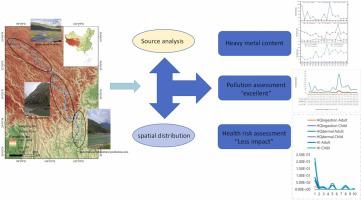当前位置:
X-MOL 学术
›
Process Saf. Environ. Prot.
›
论文详情
Our official English website, www.x-mol.net, welcomes your feedback! (Note: you will need to create a separate account there.)
Spatial distribution, sources and human health risk assessment of dissolved heavy metals and metalloids in Yalong River, China
Process Safety and Environmental Protection ( IF 6.9 ) Pub Date : 2024-06-19 , DOI: 10.1016/j.psep.2024.06.055 Xin Gao , Liping Qiu , Longxiang Fang , Zhuping Liu , Shunlong Meng , Jiazhang Chen , Xiaofeng Huang , Shuai Zhai , Bo Sun , Chao Song
Process Safety and Environmental Protection ( IF 6.9 ) Pub Date : 2024-06-19 , DOI: 10.1016/j.psep.2024.06.055 Xin Gao , Liping Qiu , Longxiang Fang , Zhuping Liu , Shunlong Meng , Jiazhang Chen , Xiaofeng Huang , Shuai Zhai , Bo Sun , Chao Song

|
The adverse effects of metal(loid) accumulation on ecological health and human health have attracted widespread attention from the society, and the reduction of species diversity in the whole Yalong River basin due to dam construction. In this study, we investigated the distribution characteristics of metal(loid)s in the whole Yalong River basin from the point of view of metal(loid)s, identified the pollution sources, assessed the risk level, and further evaluated the risk to human health. A total of 9 heavy metals (Cr, Mn, Fe, Ni, Ag, Cd, Pb, Cu and Zn) and 1 metalloid (As) were investigated and surface water samples were collected from 17 sites along the Yalong River, which were categorized into industrial and agricultural production zones (YL1–5), alpine canyon zones (YL6–12), and alpine meadow zones (YL13–17) based on altitude and habitat. The results indicated that the density of metal(loid) in the alpine meadow area was considerably highest compared to other areas. The Zn content ranged from 64.42 to 84.55 μg/L, the Mn concentration ranged from 7.47 to 20.03 μg/L, and the Pb value ranged from 0.63 to 3.44 μg/L. In other places, the concentrations for Zn ranged from 17.88 to 37.78 μg/L, for Mn they ranged from 2.84 to 12.86 μg/L, and for Pb they ranged from 0.16 to 0.50 μg/L. The main sources of the metal(loid)s were determined by correlation analysis (CA) and principal component analysis (PCA) to be from natural factors such as crustal movement, atmospheric deposition, and water-rock washout. The water quality of Yalong River was evaluated by HEI, NI and WQI indices, and the results showed that the overall water quality of Yalong River was "excellent", in which the water quality of the alpine meadow area was better than that of the industrial and agricultural production area and the alpine canyon area. HQ, HQ and HI values are calculated to expose the harm caused by metal(loid) elements. The results indicate that all of the aforementioned values are below 1, suggesting that the potential harm caused by these elements is minimal. The value of HQ tends to be higher than HQ. Consequently, skin contact is likely the primary mechanism of exposure. This study provides a reference basis for metal(loid) detection and ecological changes caused by the dam construction process, and provides an important basis for the use and protection of surface water in the Yalong River.
中文翻译:

雅砻江地区溶解性重金属和类金属空间分布、来源及人体健康风险评估
金属(类)积累对生态健康和人类健康的不利影响已引起社会广泛关注,大坝建设导致雅砻江全流域物种多样性减少。本研究从金属(类)物的角度调查了雅砻江流域全域金属(类)物的分布特征,识别了污染源,评估了风险等级,进一步评估了对人类的风险。健康。对雅砻江沿岸 17 个地点的地表水样品进行了 9 种重金属(Cr、Mn、Fe、Ni、Ag、Cd、Pb、Cu 和 Zn)和 1 种类金属(As)的调查,并进行了分类根据海拔和生境分为工农业生产区(YL1-5)、高山峡谷区(YL6-12)和高山草甸区(YL13-17)。结果表明,高寒草甸地区金属(类)密度明显高于其他地区。 Zn含量范围为64.42~84.55μg/L,Mn浓度范围为7.47~20.03μg/L,Pb值范围为0.63~3.44μg/L。其他地方Zn的浓度为17.88~37.78μg/L,Mn的浓度为2.84~12.86μg/L,Pb的浓度为0.16~0.50μg/L。通过相关分析(CA)和主成分分析(PCA)确定金属(类)的主要来源为地壳运动、大气沉降、水岩冲刷等自然因素。 采用HEI、NI、WQI指数对雅砻江水质进行评价,结果显示,雅砻江水质总体为“优”,其中高寒草甸区水质优于工业区水质。农业生产区和高山峡谷区。计算HQ、HQ和HI值以暴露金属(类)元素造成的危害。结果表明,上述所有值均低于 1,表明这些元素造成的潜在危害很小。 HQ的价值往往高于HQ。因此,皮肤接触可能是主要的暴露机制。该研究为大坝建设过程中金属(物)检测和生态变化提供参考依据,为雅砻江地表水的利用和保护提供重要依据。
更新日期:2024-06-19
中文翻译:

雅砻江地区溶解性重金属和类金属空间分布、来源及人体健康风险评估
金属(类)积累对生态健康和人类健康的不利影响已引起社会广泛关注,大坝建设导致雅砻江全流域物种多样性减少。本研究从金属(类)物的角度调查了雅砻江流域全域金属(类)物的分布特征,识别了污染源,评估了风险等级,进一步评估了对人类的风险。健康。对雅砻江沿岸 17 个地点的地表水样品进行了 9 种重金属(Cr、Mn、Fe、Ni、Ag、Cd、Pb、Cu 和 Zn)和 1 种类金属(As)的调查,并进行了分类根据海拔和生境分为工农业生产区(YL1-5)、高山峡谷区(YL6-12)和高山草甸区(YL13-17)。结果表明,高寒草甸地区金属(类)密度明显高于其他地区。 Zn含量范围为64.42~84.55μg/L,Mn浓度范围为7.47~20.03μg/L,Pb值范围为0.63~3.44μg/L。其他地方Zn的浓度为17.88~37.78μg/L,Mn的浓度为2.84~12.86μg/L,Pb的浓度为0.16~0.50μg/L。通过相关分析(CA)和主成分分析(PCA)确定金属(类)的主要来源为地壳运动、大气沉降、水岩冲刷等自然因素。 采用HEI、NI、WQI指数对雅砻江水质进行评价,结果显示,雅砻江水质总体为“优”,其中高寒草甸区水质优于工业区水质。农业生产区和高山峡谷区。计算HQ、HQ和HI值以暴露金属(类)元素造成的危害。结果表明,上述所有值均低于 1,表明这些元素造成的潜在危害很小。 HQ的价值往往高于HQ。因此,皮肤接触可能是主要的暴露机制。该研究为大坝建设过程中金属(物)检测和生态变化提供参考依据,为雅砻江地表水的利用和保护提供重要依据。











































 京公网安备 11010802027423号
京公网安备 11010802027423号